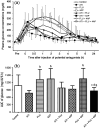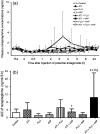Effects in cats of atipamezole, flumazenil and 4-aminopyridine on stress-related neurohormonal and metabolic responses induced by medetomidine, midazolam and ketamine
- PMID: 25366173
- PMCID: PMC11104056
- DOI: 10.1177/1098612X14556557
Effects in cats of atipamezole, flumazenil and 4-aminopyridine on stress-related neurohormonal and metabolic responses induced by medetomidine, midazolam and ketamine
Abstract
This study aimed to investigate the antagonistic effects of a fixed dose of atipamezole (ATI), flumazenil (FLU) and 4-aminopyridine (4AP), both alone and in various combinations, on key stress-related neurohormonal and metabolic changes induced by medetomidine (MED), midazolam (MID) and ketamine (KET) in healthy cats. Seven cats were used consistently in eight investigation groups. Cats were administered a mixture of 0.05 mg/kg MED and 0.5 mg/kg MID followed 10 mins later by 10 mg/kg KET intramuscularly. Twenty minutes after KET injection, the cats were intravenously injected with either a physiological saline solution at 0.1 ml/kg (control) or one of the seven variations of experimental drugs, alone or in combination: ATI, FLU, 4AP, ATI + FLU, FLU + 4AP, ATI + 4AP and ATI + FLU + 4AP. Blood samples were collected 10 times during the 24 h test period. Plasma glucose, insulin, cortisol, epinephrine, norepinephrine and non-esterified fatty acid levels were measured. The administration of MED + MID + KET resulted in hyperglycaemia and decreases in epinephrine, norepinephrine, cortisol and non-esterified fatty acid levels. FLU or 4AP alone or FLU + 4AP did not effectively antagonise the effects induced by MED + MID + KET but enhanced the hyperglycaemia. ATI alone was effective in antagonising these effects. Compared with non-ATI regimens, combinations with ATI were more effective in antagonising the effects induced by MED + MID + KET; however, ATI + FLU + 4AP caused large increases in cortisol, epinephrine and norepinephrine concentrations. ATI, both alone and in combination, is effective in antagonising the neurohormonal and metabolic effects of MED + MID + KET in cats. However, ATI + FLU + 4AP is not suitable because of large stress-related hormonal responses.
© ISFM and AAFP 2014.
Conflict of interest statement
The authors do not have any potential conflicts of interest to declare.
Figures






Similar articles
-
Antagonistic effects of atipamezole, flumazenil and 4-aminopyridine against anaesthesia with medetomidine, midazolam and ketamine combination in cats.J Feline Med Surg. 2008 Feb;10(1):47-54. doi: 10.1016/j.jfms.2007.06.013. Epub 2007 Sep 4. J Feline Med Surg. 2008. PMID: 17766159 Free PMC article.
-
Partial antagonization of midazolam-medetomidine-ketamine in cats--atipamezole versus combined atipamezole and flumazenil.J Vet Med A Physiol Pathol Clin Med. 2007 Nov;54(9):518-21. doi: 10.1111/j.1439-0442.2007.00971.x. J Vet Med A Physiol Pathol Clin Med. 2007. PMID: 17931228
-
Reversal effects of atipamezole, flumazenil, and 4-aminopyridine on bradycardia and increases in blood pressures induced by medetomidine, midazolam, and ketamine in isoflurane-anesthetized cats.J Vet Emerg Crit Care (San Antonio). 2022 Mar;32(2):207-215. doi: 10.1111/vec.13154. Epub 2021 Oct 27. J Vet Emerg Crit Care (San Antonio). 2022. PMID: 34704354
-
Antagonistic activities of atipamezole, 4-aminopyridine and yohimbine against medetomidine/ketamine-induced anaesthesia in cats.Vet Rec. 1991 Jan 19;128(3):57-60. doi: 10.1136/vr.128.3.57. Vet Rec. 1991. PMID: 2003354
-
Effects of medetomidine and midazolam alone or in combination on the metabolic and neurohormonal responses in healthy cats.Can J Vet Res. 2008 Jul;72(4):332-9. Can J Vet Res. 2008. PMID: 18783022 Free PMC article. Clinical Trial.
Cited by
-
Tools for the Approach of Fear, Anxiety, and Stress in the Domestic Feline: An Update.Vet Med Int. 2025 Aug 6;2025:9109397. doi: 10.1155/vmi/9109397. eCollection 2025. Vet Med Int. 2025. PMID: 40809800 Free PMC article. Review.
-
Changes in energy metabolism, and levels of stress-related hormones and electrolytes in horses after intravenous administration of romifidine and the peripheral α-2 adrenoceptor antagonist vatinoxan.Acta Vet Scand. 2018 May 9;60(1):27. doi: 10.1186/s13028-018-0380-x. Acta Vet Scand. 2018. PMID: 29743097 Free PMC article.
-
Proteostasis in epicardial versus subcutaneous adipose tissue in heart failure subjects with and without diabetes.Biochim Biophys Acta Mol Basis Dis. 2018 Jun;1864(6 Pt A):2183-2198. doi: 10.1016/j.bbadis.2018.03.025. Epub 2018 Apr 4. Biochim Biophys Acta Mol Basis Dis. 2018. PMID: 29625179 Free PMC article.
-
Effects of pretreatment with medetomidine, midazolam, ketamine, and their combinations on stress-related hormonal and metabolic responses in isoflurane-anesthetized cats undergoing surgery.J Adv Vet Anim Res. 2021 Nov 1;8(4):563-575. doi: 10.5455/javar.2021.h546. eCollection 2021 Dec. J Adv Vet Anim Res. 2021. PMID: 35106295 Free PMC article.
References
Publication types
MeSH terms
Substances
LinkOut - more resources
Full Text Sources
Other Literature Sources
Medical
Miscellaneous

